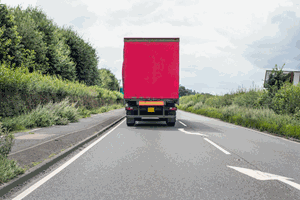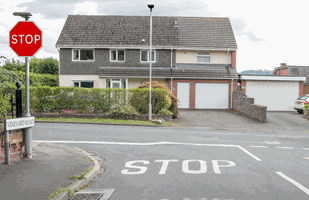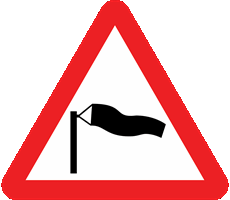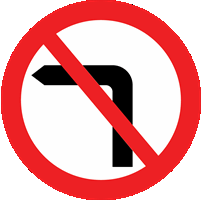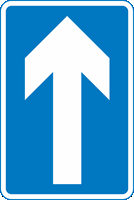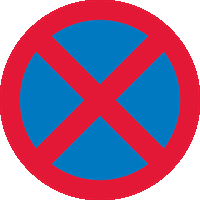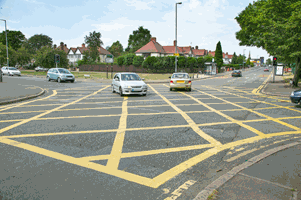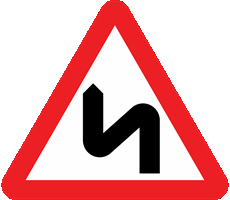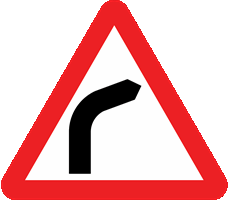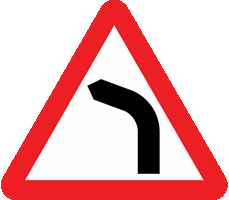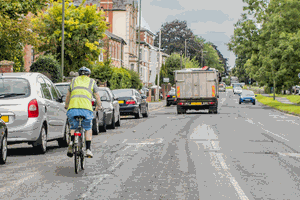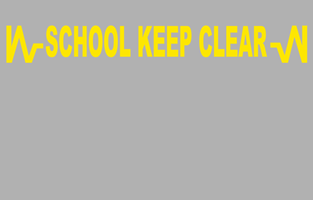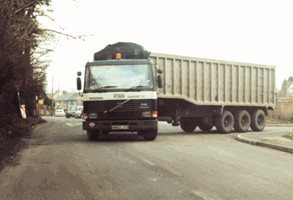You have 57 minutes to answer 50 multiple choice driving theory test questions. You need to answer at least 43 out of 50 questions correctly to pass. You can review your answer after each question or you can review all of your answers at the end of the test. Best of luck!
Test Quick View
Click on an answer to view the correct choice along with the explanation.
Correct Answer: D
Explanation: Staying back will increase your view of the road ahead. This will help you to see any hazards that might occur and allow you more time to react.
Explanation: Staying back will increase your view of the road ahead. This will help you to see any hazards that might occur and allow you more time to react.
پیچھے رہنے سے آپ کو آگے زیادہ سڑک دکھائی دے گی۔ یہ آپ کو کسی ممکنہ خطرے کو دیکھنے اور اس سے بچاو کے لئے مدد کرتا ہے
Correct Answer: B
Explanation: Always give cyclists plenty of room when overtaking them. You need to give them even more room when it's windy. A sudden gust could easily blow them off course and into your path.
Explanation: Always give cyclists plenty of room when overtaking them. You need to give them even more room when it's windy. A sudden gust could easily blow them off course and into your path.
Correct Answer: A
Explanation: The 'stop' sign has been put here because the view into the main road is poor. You must stop because it won't be possible to take proper observation while you're moving.
Explanation: The 'stop' sign has been put here because the view into the main road is poor. You must stop because it won't be possible to take proper observation while you're moving.
Correct Answer: A
Explanation: If a school crossing patrol steps out into the road with a 'stop' sign, you must stop. Don't wave anyone across the road and don't get impatient or rev your engine.
Explanation: If a school crossing patrol steps out into the road with a 'stop' sign, you must stop. Don't wave anyone across the road and don't get impatient or rev your engine.
5. You're about to overtake a slow-moving motorcyclist. Which one of these signs would make you take special care? Mark one answer
AB
C
D
Correct Answer: A
Explanation: In windy weather, watch out for motorcyclists and also cyclists, as they can be blown sideways into your path. When you pass them, leave plenty of room and check their position in your mirror before pulling back in.
Explanation: In windy weather, watch out for motorcyclists and also cyclists, as they can be blown sideways into your path. When you pass them, leave plenty of room and check their position in your mirror before pulling back in.
6. You're travelling along a motorway. Where would you find a crawler or climbing lane? Mark one answer
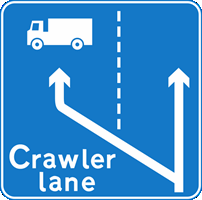
B
C
D
Correct Answer: D
Explanation: Large, slow-moving vehicles can hinder the progress of other traffic. On a steep gradient, an extra crawler lane may be provided for slow-moving vehicles to allow faster-moving traffic to flow more easily.
Explanation: Large, slow-moving vehicles can hinder the progress of other traffic. On a steep gradient, an extra crawler lane may be provided for slow-moving vehicles to allow faster-moving traffic to flow more easily.
Correct Answer: B
Explanation: The studs between the carriageway and the hard shoulder are normally red. These change to green where there's a slip road, helping you to identify slip roads when visibility is poor or when it's dark.
Explanation: The studs between the carriageway and the hard shoulder are normally red. These change to green where there's a slip road, helping you to identify slip roads when visibility is poor or when it's dark.
8. You see street lights but no speed-limit signs. What will the speed limit usually be? Mark one answer
AB
C
D
Correct Answer: A
Explanation: The presence of street lights generally indicates that there's a 30 mph speed limit, unless signs tell you otherwise.
Explanation: The presence of street lights generally indicates that there's a 30 mph speed limit, unless signs tell you otherwise.
Correct Answer: A
Explanation: The purpose of yellow box markings is to keep junctions clear of queuing traffic. You may only wait in the marked area when you're turning right and your exit lane is clear but you can't complete the turn because of oncoming traffic or other traffic waiting to turning right.
Explanation: The purpose of yellow box markings is to keep junctions clear of queuing traffic. You may only wait in the marked area when you're turning right and your exit lane is clear but you can't complete the turn because of oncoming traffic or other traffic waiting to turning right.
Correct Answer: B
Explanation: Triangular signs give you a warning of hazards ahead. They're there to give you time to prepare for the hazard; for example, by adjusting your speed.
Explanation: Triangular signs give you a warning of hazards ahead. They're there to give you time to prepare for the hazard; for example, by adjusting your speed.
11. You see a car on the hard shoulder of a motorway with a 'help' pennant displayed. What does this mean? Mark one answer
AB
C
D
Correct Answer: D
Explanation: If a disabled driver's vehicle breaks down and they're unable to walk to an emergency phone, they're advised to stay in their car and switch on the hazard warning lights. They may also display a 'help' pennant in their vehicle.
Explanation: If a disabled driver's vehicle breaks down and they're unable to walk to an emergency phone, they're advised to stay in their car and switch on the hazard warning lights. They may also display a 'help' pennant in their vehicle.
12. You've broken down on a motorway. In which direction should you walk to find the nearest emergency telephone? Mark one answer
AB
C
D
Correct Answer: C
Explanation: Along the hard shoulder there are marker posts at 100-metre intervals. These will direct you to the nearest emergency telephone.
Explanation: Along the hard shoulder there are marker posts at 100-metre intervals. These will direct you to the nearest emergency telephone.
13. You see a horse rider as you approach a roundabout. What should you do if they're signalling right but keeping well to the left? Mark one answer
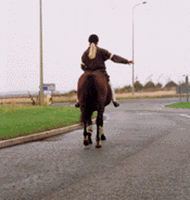
B
C
D
Correct Answer: D
Explanation: Allow the horse rider to enter and exit the roundabout in their own time. They may feel safer keeping to the left all the way around the roundabout. Don't get up close behind or alongside them, because that would probably upset the horse and create a dangerous situation.
Explanation: Allow the horse rider to enter and exit the roundabout in their own time. They may feel safer keeping to the left all the way around the roundabout. Don't get up close behind or alongside them, because that would probably upset the horse and create a dangerous situation.
14. You're travelling on a road that has speed humps. What should you do when the driver in front is travelling more slowly than you? Mark one answer
AB
C
D
Correct Answer: C
Explanation: Be patient and stay behind the car in front. You shouldn't normally overtake other vehicles in areas subject to traffic calming. If you overtake here, you may easily exceed the speed limit, defeating the purpose of the traffic-calming measures.
Explanation: Be patient and stay behind the car in front. You shouldn't normally overtake other vehicles in areas subject to traffic calming. If you overtake here, you may easily exceed the speed limit, defeating the purpose of the traffic-calming measures.
15. Powered vehicles used by disabled people are small and hard to see. How do they give early warning when on a dual carriageway? Mark one answer
AB
C
D
Correct Answer: A
Explanation: Powered vehicles used by disabled people are small, low, hard to see and travel very slowly. On a dual carriageway, a flashing amber light will warn other road users.
Explanation: Powered vehicles used by disabled people are small, low, hard to see and travel very slowly. On a dual carriageway, a flashing amber light will warn other road users.
16. Other drivers may sometimes flash their headlights at you. In which situation are they allowed to do this? Mark one answer
AB
C
D
Correct Answer: D
Explanation: If other drivers flash their headlights, this isn't a signal to show priority. The flashing of headlights has the same meaning as sounding the horn: it's a warning of their presence.
Explanation: If other drivers flash their headlights, this isn't a signal to show priority. The flashing of headlights has the same meaning as sounding the horn: it's a warning of their presence.
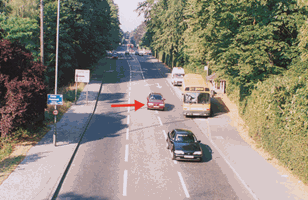
B
C
D
Correct Answer: D
Explanation: If you can do so safely, give way to buses signalling to move off at bus stops. Try to anticipate the actions of other road users around you. The driver of the red car should be prepared for the bus pulling out. As you approach a bus stop, look to see how many passengers are waiting to board. If the last one has just got on, the bus is likely to move off.
Explanation: If you can do so safely, give way to buses signalling to move off at bus stops. Try to anticipate the actions of other road users around you. The driver of the red car should be prepared for the bus pulling out. As you approach a bus stop, look to see how many passengers are waiting to board. If the last one has just got on, the bus is likely to move off.
Correct Answer: C
Explanation: When following a cyclist, be aware that they have to deal with the hazards around them. They may wobble or swerve to avoid a pothole in the road or see a potential hazard and change direction suddenly. Don't follow them too closely or rev your engine impatiently.
Explanation: When following a cyclist, be aware that they have to deal with the hazards around them. They may wobble or swerve to avoid a pothole in the road or see a potential hazard and change direction suddenly. Don't follow them too closely or rev your engine impatiently.
Correct Answer: C
Explanation: These markings are found on the road outside schools. Don't stop or park on them, even to set down or pick up children. The markings are there to ensure that drivers, riders, children and other pedestrians have a clear view of the road in all directions.
Explanation: These markings are found on the road outside schools. Don't stop or park on them, even to set down or pick up children. The markings are there to ensure that drivers, riders, children and other pedestrians have a clear view of the road in all directions.
20. What should you do when you're approaching a bus that's signalling to move away from a bus stop? Mark one answer
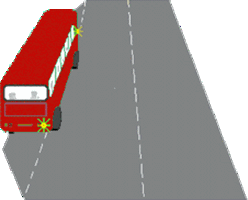
B
C
D
Correct Answer: A
Explanation: Try to give way to buses if you can do so safely, especially when the driver signals to pull away from a bus stop. Look out for people getting off the bus or running to catch it, because they may cross the road without looking. Don't accelerate to get past the bus, and don't flash your lights, as this could mislead other road users.
Explanation: Try to give way to buses if you can do so safely, especially when the driver signals to pull away from a bus stop. Look out for people getting off the bus or running to catch it, because they may cross the road without looking. Don't accelerate to get past the bus, and don't flash your lights, as this could mislead other road users.
Correct Answer: D
Explanation: When turning, long vehicles need much more room on the road than other vehicles. At junctions, they may take up the whole of the road space, so be patient and allow them the room they need.
Explanation: When turning, long vehicles need much more room on the road than other vehicles. At junctions, they may take up the whole of the road space, so be patient and allow them the room they need.
Correct Answer: A
Explanation: The hard shoulder should only be used in a genuine emergency. If possible, and if it's safe, use a roadside telephone to call for help. This will give your exact location to the operator. Never cross the carriageway or a slip road to use a telephone on the other side of the road.
Explanation: The hard shoulder should only be used in a genuine emergency. If possible, and if it's safe, use a roadside telephone to call for help. This will give your exact location to the operator. Never cross the carriageway or a slip road to use a telephone on the other side of the road.
23. Why can it be an advantage for traffic speed to stay constant over a longer distance? Mark one answer
AB
C
D
Correct Answer: D
Explanation: When traffic travels at a constant speed over a longer distance, journey times normally improve. You may feel that you could travel faster for short periods, but this generally leads to bunching and increased overall journey time.
Explanation: When traffic travels at a constant speed over a longer distance, journey times normally improve. You may feel that you could travel faster for short periods, but this generally leads to bunching and increased overall journey time.
24. You're on a dual carriageway. Ahead, you see a vehicle with an amber flashing light. What could this be? Mark one answer
AB
C
D
Correct Answer: A
Explanation: An amber flashing light on a vehicle indicates that it's slow-moving. Battery-powered vehicles used by disabled people are limited to 8 mph. It isn't advisable for them to be used on dual carriageways where the speed limit exceeds 50 mph. If they are, then an amber flashing light must be used.
Explanation: An amber flashing light on a vehicle indicates that it's slow-moving. Battery-powered vehicles used by disabled people are limited to 8 mph. It isn't advisable for them to be used on dual carriageways where the speed limit exceeds 50 mph. If they are, then an amber flashing light must be used.
Correct Answer: D
Explanation: The vehicle excise licence (road tax) can be renewed at post offices, vehicle registration offices, online or by phone. When applying, make sure you have all the relevant valid documents, including a valid MOT test certificate where applicable.
Explanation: The vehicle excise licence (road tax) can be renewed at post offices, vehicle registration offices, online or by phone. When applying, make sure you have all the relevant valid documents, including a valid MOT test certificate where applicable.
26. At an incident, it's important to look after any casualties. What should you do with them when the area is safe? Mark one answer
AB
C
D
Correct Answer: C
Explanation: When the area is safe and there's no danger from other traffic or fire, it's better not to move casualties. Moving them may cause further injury.
Explanation: When the area is safe and there's no danger from other traffic or fire, it's better not to move casualties. Moving them may cause further injury.
A
B
C
D
B
C
D
Correct Answer: C
Explanation: Unblocking the casualty's airway and gently tilting their head back will help them to breathe. They'll then be in the correct position if mouth-to-mouth resuscitation is required. Don't move a casualty unless there's further danger.
Explanation: Unblocking the casualty's airway and gently tilting their head back will help them to breathe. They'll then be in the correct position if mouth-to-mouth resuscitation is required. Don't move a casualty unless there's further danger.
28. You're at the scene of an incident. Someone is suffering from shock. How should you treat them? Mark one answer
AB
C
D
Correct Answer: D
Explanation: If someone is suffering from shock, try to keep them warm and as comfortable as you can. Don't give them anything to eat or drink but reassure them confidently and try not to leave them alone.
Explanation: If someone is suffering from shock, try to keep them warm and as comfortable as you can. Don't give them anything to eat or drink but reassure them confidently and try not to leave them alone.
29. You're driving in traffic at the speed limit for the road. What should you do if the driver behind is trying to overtake? Mark one answer
AB
C
D
Correct Answer: B
Explanation: Keep a steady course to give the driver behind an opportunity to overtake safely. If necessary, slow down. Reacting incorrectly to another driver's impatience can lead to danger.
Explanation: Keep a steady course to give the driver behind an opportunity to overtake safely. If necessary, slow down. Reacting incorrectly to another driver's impatience can lead to danger.
30. There's a bus lane on your left. The signs show no times of operation. What does this mean? Mark one answer

B
C
D
Correct Answer: A
Explanation: Bus-lane signs show the vehicles allowed to use the lane and also its times of operation. Where no times are shown, the bus lane is in operation 24 hours a day.
Explanation: Bus-lane signs show the vehicles allowed to use the lane and also its times of operation. Where no times are shown, the bus lane is in operation 24 hours a day.
Correct Answer: D
Explanation: Brakes can overheat and lose efficiency when they're used continually, such as on a long, steep, downhill stretch of road. Using a lower gear when you drive downhill can help prevent the vehicle from gaining speed.
Explanation: Brakes can overheat and lose efficiency when they're used continually, such as on a long, steep, downhill stretch of road. Using a lower gear when you drive downhill can help prevent the vehicle from gaining speed.
32. You're about to go down a steep hill. What should you do to control the speed of your vehicle? Mark one answer
AB
C
D
Correct Answer: D
Explanation: When driving down a steep hill, gravity will cause your vehicle to speed up. This will make it more difficult for you to stop. To help keep your vehicle's speed under control, select a lower gear to give you more engine braking and make careful use of the brakes.
Explanation: When driving down a steep hill, gravity will cause your vehicle to speed up. This will make it more difficult for you to stop. To help keep your vehicle's speed under control, select a lower gear to give you more engine braking and make careful use of the brakes.
33. During periods of illness, your ability to drive may be impaired. What must you do? Mark one answer
AB
C
D
Correct Answer: A
Explanation: Only drive if you're fit to do so. Driving when you're ill or taking some medicines can affect your concentration and judgement. It may also cause you to become drowsy or even fall asleep.
Explanation: Only drive if you're fit to do so. Driving when you're ill or taking some medicines can affect your concentration and judgement. It may also cause you to become drowsy or even fall asleep.
34. You're driving on the motorway in windy conditions. What should you do as you pass a high-sided vehicle? Mark one answer
AB
C
D
Correct Answer: A
Explanation: The draught caused by other vehicles - particularly those with high sides - could be strong enough to push you out of your lane. Be prepared for a sudden gust of wind as you pass large vehicles. Keep both hands on the steering wheel to help you keep full control.
Explanation: The draught caused by other vehicles - particularly those with high sides - could be strong enough to push you out of your lane. Be prepared for a sudden gust of wind as you pass large vehicles. Keep both hands on the steering wheel to help you keep full control.
35. Your car needs to pass an MOT test. What may be invalidated if you drive the car without a current MOT certificate? Mark one answer
AB
C
D
Correct Answer: C
Explanation: If your vehicle requires an MOT certificate, it's illegal to drive it without one and your insurance may be invalid if you do so. The only exceptions are that you may drive to a pre-arranged MOT test appointment, or to a garage for repairs required for the test.
Explanation: If your vehicle requires an MOT certificate, it's illegal to drive it without one and your insurance may be invalid if you do so. The only exceptions are that you may drive to a pre-arranged MOT test appointment, or to a garage for repairs required for the test.
Correct Answer: D
Explanation: If the wheels of your vehicle lock, they won't grip the road and you'll lose steering control. In good conditions, the anti-lock braking system (ABS) will prevent the wheels from locking and you'll keep control of your steering. In poor weather conditions or on loose surfaces, the ABS may be less effective.
Explanation: If the wheels of your vehicle lock, they won't grip the road and you'll lose steering control. In good conditions, the anti-lock braking system (ABS) will prevent the wheels from locking and you'll keep control of your steering. In poor weather conditions or on loose surfaces, the ABS may be less effective.
37. In which conditions are your anti-lock brakes most unlikely to prevent skidding? Mark one answer
AB
C
D
Correct Answer: D
Explanation: Anti-lock brakes may be ineffective on gravel or loose surfaces. They may also be ineffective in very wet weather, when water can build up between the tyre and the road surface; this is known as aquaplaning.
Explanation: Anti-lock brakes may be ineffective on gravel or loose surfaces. They may also be ineffective in very wet weather, when water can build up between the tyre and the road surface; this is known as aquaplaning.
38. On which occasion should you inflate your tyres to more than their normal pressure? Mark one answer
AB
C
D
Correct Answer: A
Explanation: Check the vehicle handbook. This should give you guidance on the correct tyre pressures for your vehicle and when you may need to adjust them. If you're carrying a heavy load, you may need to adjust the headlights as well. Most cars have a switch on the dashboard to do this.
Explanation: Check the vehicle handbook. This should give you guidance on the correct tyre pressures for your vehicle and when you may need to adjust them. If you're carrying a heavy load, you may need to adjust the headlights as well. Most cars have a switch on the dashboard to do this.
Correct Answer: B
Explanation: Briefly using your hazard warning lights will warn the traffic travelling behind you that there's a hazard ahead. This can reduce the chance of vehicles crashing into the back of each other.
Explanation: Briefly using your hazard warning lights will warn the traffic travelling behind you that there's a hazard ahead. This can reduce the chance of vehicles crashing into the back of each other.
40. You're driving at night with your headlights on full beam. A vehicle is overtaking you. When should you dip your lights? Mark one answer
AB
C
D
Correct Answer: A
Explanation: On full beam, your lights could dazzle the driver in front. Dip your lights as soon as the driver passes you and drop back so that the dipped beam falls short of the other vehicle.
Explanation: On full beam, your lights could dazzle the driver in front. Dip your lights as soon as the driver passes you and drop back so that the dipped beam falls short of the other vehicle.
A
B
C
D
B
C
D
Correct Answer: D
Explanation: This is more likely to happen on vehicles fitted with drum brakes, but it can apply to disc brakes as well. Using a lower gear will assist the braking and help you to keep control of your vehicle.
Explanation: This is more likely to happen on vehicles fitted with drum brakes, but it can apply to disc brakes as well. Using a lower gear will assist the braking and help you to keep control of your vehicle.
Correct Answer: D
Explanation: Diesel fuel can spill out if your filler cap isn't secured properly. This is most likely to occur on bends, junctions and roundabouts, where it will make the road slippery, especially if it's wet. At the end of a dry spell of weather, the road surfaces may have a high level of diesel spillage that hasn't been washed away by rain.
Explanation: Diesel fuel can spill out if your filler cap isn't secured properly. This is most likely to occur on bends, junctions and roundabouts, where it will make the road slippery, especially if it's wet. At the end of a dry spell of weather, the road surfaces may have a high level of diesel spillage that hasn't been washed away by rain.
43. You've just driven out of fog. What must you do now that visibility has improved? Mark one answer
AB
C
D
Correct Answer: D
Explanation: You must turn off your fog lights if visibility is more than 100 metres (328 feet). Be prepared for the fact that the fog may be patchy and you may need to turn them on again if the fog returns.
Explanation: You must turn off your fog lights if visibility is more than 100 metres (328 feet). Be prepared for the fact that the fog may be patchy and you may need to turn them on again if the fog returns.
Correct Answer: B
Explanation: Learner drivers benefit by combining professional driving lessons with private practice. However, you need to be at least 21 years old and have held your driving licence for at least 3 years before you can supervise a learner driver.
Explanation: Learner drivers benefit by combining professional driving lessons with private practice. However, you need to be at least 21 years old and have held your driving licence for at least 3 years before you can supervise a learner driver.
45. You're planning to tow a caravan. Which of these will be the biggest aid to the vehicle handling? Mark one answer
AB
C
D
Correct Answer: B
Explanation: Towing a caravan or trailer affects the way the towing vehicle handles. A stabiliser device is not designed to overcome instability caused by incorrect loading but it can give added security in side winds and from buffeting caused by large vehicles.
Explanation: Towing a caravan or trailer affects the way the towing vehicle handles. A stabiliser device is not designed to overcome instability caused by incorrect loading but it can give added security in side winds and from buffeting caused by large vehicles.
46. You claim on your insurance to have your car repaired. Your policy has an excess of £100. What does this mean? Mark one answer
AB
C
D
Correct Answer: C
Explanation: Having an excess on your policy will help to keep the premium down. However, if you make a claim, you'll have to pay the excess yourself - in this case, £100.
Explanation: Having an excess on your policy will help to keep the premium down. However, if you make a claim, you'll have to pay the excess yourself - in this case, £100.
47. You're in a tunnel. Your vehicle is on fire and you can't drive it. What should you do? Mark one answer
AB
C
D
Correct Answer: D
Explanation: It's usually better to drive a burning vehicle out of a tunnel. If you can't do this, pull over and stop at an emergency point if possible. Switch off the engine, use hazard warning lights, and leave the vehicle immediately. Call for help from the nearest emergency point. If you have an extinguisher it may help to put out a small fire, but don't try to tackle a large one.
Explanation: It's usually better to drive a burning vehicle out of a tunnel. If you can't do this, pull over and stop at an emergency point if possible. Switch off the engine, use hazard warning lights, and leave the vehicle immediately. Call for help from the nearest emergency point. If you have an extinguisher it may help to put out a small fire, but don't try to tackle a large one.
48. You're carrying a child in your car. They're under three years old. Which of these is a suitable restraint? Mark one answer
AB
C
D
Correct Answer: A
Explanation: It's your responsibility to ensure that all children in your car are secure. Suitable restraints include a child seat, baby seat, booster seat or booster cushion. It's essential that any restraint used is suitable for the child's size and weight, and fitted according to the manufacturer's instructions.
Explanation: It's your responsibility to ensure that all children in your car are secure. Suitable restraints include a child seat, baby seat, booster seat or booster cushion. It's essential that any restraint used is suitable for the child's size and weight, and fitted according to the manufacturer's instructions.
49. You're parked at the side of the road. You'll be waiting some time for a passenger. What should you do? Mark one answer
AB
C
D
Correct Answer: B
Explanation: If your vehicle is stationary and is likely to remain so for some time, switch off the engine. We should all try to reduce global warming and pollution.
Explanation: If your vehicle is stationary and is likely to remain so for some time, switch off the engine. We should all try to reduce global warming and pollution.
Correct Answer: B
Explanation: On the approach to tunnels, a sign will usually show a local radio channel. This should give a warning of any incidents or congestion in the tunnel ahead. Many radios can be set to automatically pick up traffic announcements and local frequencies. If you have to tune the radio manually, don't be distracted while doing so. Incidents in tunnels can lead to serious casualties. The greatest hazard is fire. Getting an advance warning of problems could save your life and others.
Explanation: On the approach to tunnels, a sign will usually show a local radio channel. This should give a warning of any incidents or congestion in the tunnel ahead. Many radios can be set to automatically pick up traffic announcements and local frequencies. If you have to tune the radio manually, don't be distracted while doing so. Incidents in tunnels can lead to serious casualties. The greatest hazard is fire. Getting an advance warning of problems could save your life and others.



